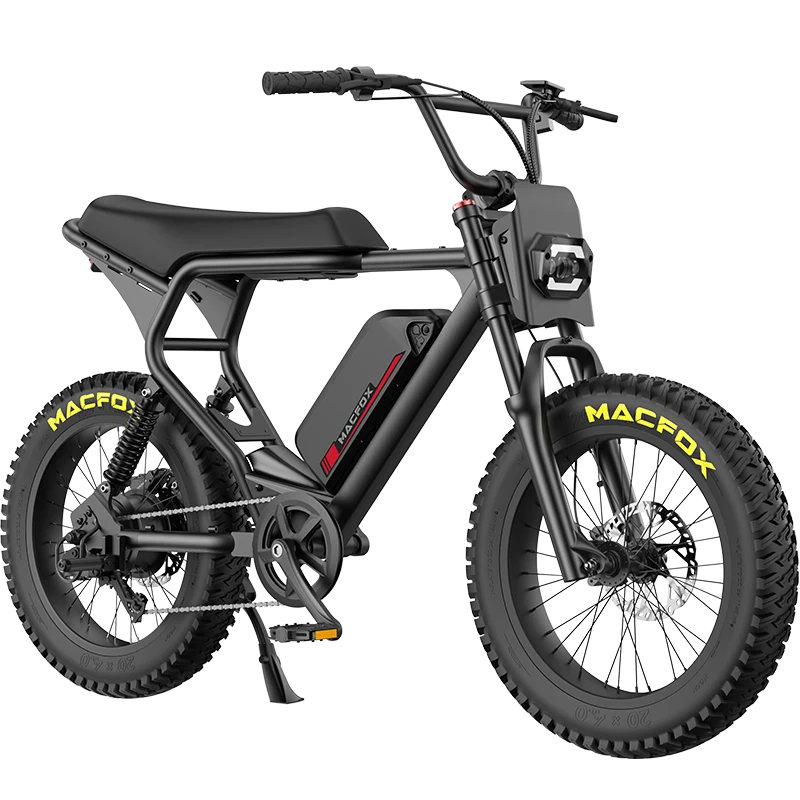If you've ever wondered whether you can shorten your electric bike chain without specialized tools, the answer is yes—but with a giant asterisk. In this guide, we’ll walk through emergency methods, the major risks involved, and why these are last-ditch solutions only. Buckle up: this is everything you need to know about tool-less e-bike chain repair.
Why E-Bike Chains Are Not Like Regular Bike Chains
Let’s start with the basics. An electric bike chain isn’t your average pedal-powered metal link. These chains are beefed up to handle motorized torque—sometimes 3x or more the force of a human pedaling. That means they're:
-
Made from stronger alloys
-
Designed to handle between 250W to 750W (or more) of output
-
Often coated with materials like nickel or titanium for durability
-
Built with tight tolerances for multi-speed systems and smooth shifting
Trying to hack, punch, or hammer a chain like this? It’s like trying to open a can with a fork. It might work, but it probably won’t end well.
Why Chain Length Matters on an E-Bike
If your chain is too long, it’ll sag, skip, or derail. Too short? You could break components—or the chain entirely—especially under high motor load.
Here's what could happen with incorrect chain length:
-
Premature wear on cogs and chainrings
-
Excess strain on derailleurs
-
Internal motor strain (yes, the motor!)
-
Increased chances of snapping under torque
With e-bikes, drivetrain health is interconnected. A weak link (literally) can send the whole system into chaos.
The Smart Way: Using a Chain Tool (Highly Recommended)
Before we get into tool-less methods, let’s talk about the real MVP—the chain breaker tool.
A chain tool precisely pushes the pin out just far enough to disconnect a link without damaging it. It allows for:
-
Safe link removal
-
Accurate reassembly
-
Minimal wear and tear
-
Long-term reliability
And the kicker? These tools cost $10–$50. Seriously, if you’re riding a $1,500+ e-bike, there’s no excuse not to have one.
Emergency Tool-Less Methods (Only If You Have No Other Choice)
⚠️ Big Disclaimer:
These methods should only be used in emergencies. They're imprecise, risky, and can cause more harm than good if done incorrectly.
Method 1: Hammer + Nail/Punch
This is the MacGyver method. It can work—but just barely.
What You’ll Need:
-
Hammer
-
Sturdy nail or punch
-
Hard surface or vice
-
Lots of patience
How To Do It:
-
Position the chain over a surface with a small hole underneath the pin you want to remove.
-
Align the punch/nail with the center of the pin.
-
Gently tap the pin out using the hammer.
Goal: Push the pin out just enough to disconnect the chain but not all the way. If it pops out completely, you’ll need a master link to reconnect.
Why It’s Risky:
-
Pins bend easily under blunt force.
-
Plates can deform, leading to stiff or weak links.
-
Reconnecting without proper tools is nearly impossible to do right.
Recommended: Macfox X1S E-Bike Error Codes: Ultimate Troubleshooting Guide
Method 2: Using a Master Link (If Your Chain Has One)
Master links are your best friend when you’re stuck. They’re designed to connect and disconnect chains easily—sometimes even without tools.
How To Spot One:
-
Different color or shape than the rest of the chain
-
Often found on newer or higher-end chains
How To Open It:
-
Rotate the chain so the master link is on top
-
Squeeze the plates together and push inward
-
You can also use wire or pliers for extra pressure
Note: Some master links are single-use only. Reusing them is a gamble, especially under e-bike torque.
Method 3: Cut It (Worst-Case Scenario)
This is the “you’re out of options” method. Use bolt cutters, a hacksaw, or Dremel to chop the chain. It will destroy the link and possibly the surrounding area. Not recommended unless you’re replacing the whole chain soon.
Reconnecting the Chain: Master Link vs. Reused Pin
After removing links, you’ve got to reconnect the chain. You have two options—one good, one terrible.
✅ Best Option: Use a New Master Link
It’s clean, reliable, and made for the job. Just slide the ends into the master link, snap it together (some need a pedal stomp), and you’re good to go.
Pro Tip: Always carry a spare master link that matches your chain’s speed (e.g., 9-speed, 11-speed, etc.).
❌ Worst Option: Hammer the Pin Back
Please don’t do this. If you tried the hammer method to remove the pin, putting it back is 10x worse.
Why?
-
It’s almost impossible to align perfectly
-
You’ll likely end up with a stiff link
-
It increases the chances of catastrophic chain failure under torque

What Could Go Wrong?
Plenty. Improvised chain fixes on e-bikes are playing with fire.
Here's what you're risking:
-
Snapped chains (especially mid-climb or under throttle)
-
Bent derailleurs or broken hangers
-
Damage to the motor or internal gears
-
Poor shifting and drivetrain inefficiency
-
Personal injury if the chain breaks mid-ride
Basically, you’re inviting a small problem to become a big one—fast.
Inspection After Any DIY Fix
If you do manage to shorten the chain, here’s what to check:
-
Stiff Links? Flex every link by hand. If any don’t move freely, work them gently or replace.
-
Lubrication: Apply quality lube after any chain work.
-
Alignment: Make sure the chain runs smoothly through the derailleur and over the cogs.
-
Test Ride on Low Power: Don’t immediately gun it on max assist. Test under gentle conditions first.
The Bottom Line: Always Carry a Chain Tool & Master Link
Yes, you can shorten an e-bike chain without tools—but the question is: should you? The risks to your drivetrain, motor, and personal safety are real.
Spending $20 on a proper tool and $5 on a master link could save you hundreds—or even thousands—on repairs. So don’t wait until you're stranded. Be ready.
Conclusion
While emergency chain shortening methods might get you rolling again, they’re no replacement for proper tools and preventative maintenance. The torque and complexity of e-bike drivetrains mean the stakes are simply higher than on a traditional bike.
Whether you're a weekend warrior or a daily commuter, carrying a chain tool and a compatible master link is a small price to pay for peace of mind. Your motor, cassette, and wallet will thank you.
FAQs
Q: Can I use regular bike tools on an e-bike chain?
Some tools might work, but it’s better to use e-bike-rated tools due to the higher forces involved. Always ensure compatibility, especially for master links and chain tools.
Q: How do I know what speed my e-bike chain is?
Count the number of cogs on your rear cassette. If you have 10, it’s a 10-speed. Your replacement chain and master link must match that number.
Q: What happens if my chain snaps while riding?
If the chain breaks under load, you could lose control, especially if you're accelerating or climbing. It can also damage the derailleur, motor, or even cause a crash.


















